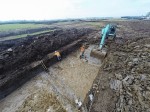 Archaeologists excavating the site of future construction in the eastern Dutch town of Tiel have unearthed an unexpectedly large number of high quality Roman artifacts. Five archaeological companies and dozens of volunteers have been working assiduously to excavate a massive area the size of 36 soccer fields by their October deadline. They started last November, so they will have less than a year to excavate 80 hectares.
Archaeologists excavating the site of future construction in the eastern Dutch town of Tiel have unearthed an unexpectedly large number of high quality Roman artifacts. Five archaeological companies and dozens of volunteers have been working assiduously to excavate a massive area the size of 36 soccer fields by their October deadline. They started last November, so they will have less than a year to excavate 80 hectares.
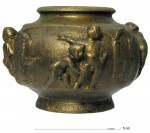 So far they have discovered an astonishing 2,500 bronze objects, most of which haven’t even been cleaned yet, but which include many fibulae, other jewelry, oil lamps and a wine sieve complete with its underplate. The most spectacular of the bronze objects is a balsamarium, a vessel that contained ointment or perfume, decorated with a relief of frolicking Eros figures. Other notable finds include a rare cameo ring with a centaur design, a limestone statue of Jupiter and a fragment of an altar or grave stone inscribed DEAE (“to the goddess”). These are not ordinary objects; only a rich Roman household would possess such a wealth of expensive goods.
So far they have discovered an astonishing 2,500 bronze objects, most of which haven’t even been cleaned yet, but which include many fibulae, other jewelry, oil lamps and a wine sieve complete with its underplate. The most spectacular of the bronze objects is a balsamarium, a vessel that contained ointment or perfume, decorated with a relief of frolicking Eros figures. Other notable finds include a rare cameo ring with a centaur design, a limestone statue of Jupiter and a fragment of an altar or grave stone inscribed DEAE (“to the goddess”). These are not ordinary objects; only a rich Roman household would possess such a wealth of expensive goods.
 The archaeological teams have excavated two burial grounds on the site, both cremation burials and inhumation burials. About 80 cremation burials were found with goods, including delicate clear glassware, scissors and a razor. An intact set of dinnerware composed of an earthenware jug, two drinking cups and a shallow bowl or plate were discovered in excellent condition. The inhumation burials, extremely rare for this period, were marked with earthen mounds. One of them is a double grave containing the remains of two babies.
The archaeological teams have excavated two burial grounds on the site, both cremation burials and inhumation burials. About 80 cremation burials were found with goods, including delicate clear glassware, scissors and a razor. An intact set of dinnerware composed of an earthenware jug, two drinking cups and a shallow bowl or plate were discovered in excellent condition. The inhumation burials, extremely rare for this period, were marked with earthen mounds. One of them is a double grave containing the remains of two babies.
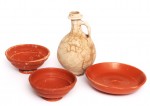 It’s not surprising that there would be Roman artifacts in Tiel. What is now the Dutch province of Gelderland was part of the Roman province of Germania Inferior, and there were several military outposts and towns along the strategically important border on the Rhine Valley, Nijmegen the largest and most important among them. Had these high quality finds been discovered in Nijmegen, they would still have been exciting and rare discoveries, but not unexpected. Tiel, on the other hand, was a backwater inhabited by Batavian farmers in mud huts with thatched roofs.
It’s not surprising that there would be Roman artifacts in Tiel. What is now the Dutch province of Gelderland was part of the Roman province of Germania Inferior, and there were several military outposts and towns along the strategically important border on the Rhine Valley, Nijmegen the largest and most important among them. Had these high quality finds been discovered in Nijmegen, they would still have been exciting and rare discoveries, but not unexpected. Tiel, on the other hand, was a backwater inhabited by Batavian farmers in mud huts with thatched roofs.
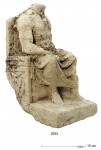 Roman artifacts were widespread throughout Roman territory — the mass production and distribution of consumer goods all over the empire attests to an attainable standard of living that after the collapse of the Western Empire would not be achieved again until the modern era — but for such a wealth of expensive goods like the wine sieve, balsamarium and centaur cameo ring to be found suggests the area may have been more thoroughly Romanized and wealthier than archaeologists realized.
Roman artifacts were widespread throughout Roman territory — the mass production and distribution of consumer goods all over the empire attests to an attainable standard of living that after the collapse of the Western Empire would not be achieved again until the modern era — but for such a wealth of expensive goods like the wine sieve, balsamarium and centaur cameo ring to be found suggests the area may have been more thoroughly Romanized and wealthier than archaeologists realized.
[Archaeologist Jan] Van der Velde has two theories. “The owner of the artefacts could have been an important Batavian who wanted to recreate a piece of Rome in his villa by surrounding himself with expensive and rare objects. But perhaps we have stumbled on a temple. Almost all the bronze objects were found in a square of 20 by 50 metres, so it may well have been a sacrificial site.”
The dig will have to shut down for the next few months to give the present-day farmer a chance to sow and reap his harvest. Van der Velde will then try to discover a floor plan so he can determine the presence of a villa or temple.
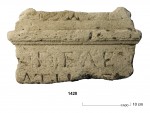 There will be an open day at the dig site on Saturday, April 8th, from 11:00 AM to 4:00 PM. A selection of the artifacts will be shown to visitors. This fall, a full exhibition on the excavation and its treasures, not just the Roman finds but archaeological material going back 6,000 years, will be held at the Flipje & Streekmuseum in Tiel.
There will be an open day at the dig site on Saturday, April 8th, from 11:00 AM to 4:00 PM. A selection of the artifacts will be shown to visitors. This fall, a full exhibition on the excavation and its treasures, not just the Roman finds but archaeological material going back 6,000 years, will be held at the Flipje & Streekmuseum in Tiel.
There’s a crop we’ll all be anxiously waiting for :yes:
There have been similar inscriptions found on the Dutch coast. Just a little to the East of what is now Tiel, there is the Insula Batavorum (Island of the Batavians, today: Overbetuwe), and a Roman impression of the area is represented on the ‘Tabula Peutingeriana’, Tabula II: The rivers Rhine (fluvius Renus) and Meuse (fluvius Patabus) are represented with towns like Katwijk (Lugdunum Batavorum), Voorburg (Forum Hadriani) or Kasselberg (Castellum Menapiorum).
:hattip:
I’m ready to order several sets of the earthenware service from De Bijenkorf (Amsterdam’s Marks & Sparks). Just great.
I read the headline as Rich Roman, subject; finds, verb; surprise, adjective; Dutch archeologists, direct object. I kept waiting for the rich Roman to find the archeologists…
This is amazing and hard to believe so many objects have gone undisturbed in Dutch pastures for so long. I wish they had more time to excavate!
More to explore
someblogz.simplesite.com